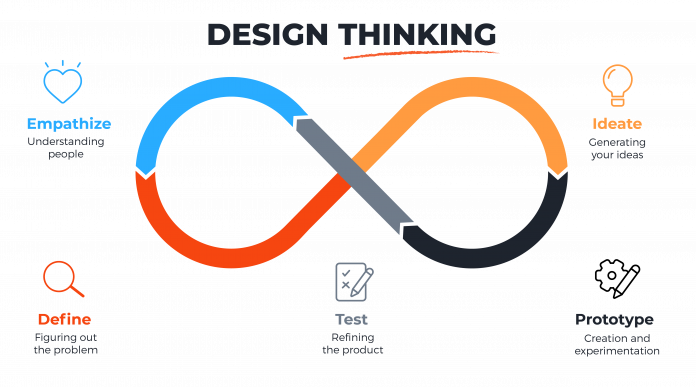What is the Design Thinking Methodology?

Design Thinking is an effective way to solve an issue. The design thinking technique is a method or process for approaching an issue strategically. Design Thinking approaches, frameworks, and tools come in a variety of forms. The tools for the Design Process are utilized at various phases of methodology to address the problem quickly. Some techniques come with their own tools, while others don’t. Some techniques are sequential, while others are iterative. In this realm of design thinking approaches, we strive to describe as many techniques and tools as possible in the methodology menu.
Design thinking is a method for approaching complicated challenges in a creative and user-centered manner. You can gain expertise in these methodologies through various design thinking certification courses available online. The following are key characteristics of the design thinking methodology:
- Concentrate on the end-users. All critical product design decisions are reviewed according to the end user’s needs and wants, which is an important part of the design thinking process.
- Problem framing is considered an excellent part of design thinking. Rather than accepting the problem as it is, designers investigate the problem space in search of an underlying cause. Designers can use the knowledge they gather to reinterpret the challenge.
- Developing practical solutions. Instead of using presentations and PowerPoint decks, use sketching and prototyping to communicate design concepts.
Double Diamond Plus
This technique is both well-known and novel. The double diamond method is one way of displaying the design process, as it depicts how designers work through four important stages: discover, define, develop, and deliver. For beginners, , they make room for a wide range of new ideas to be discovered and shared. They then aid in identifying and defining priority areas to address by concentrating on user demands. Following that, a designer will create various prototype solutions based on the identified opportunity areas. Finally, they will concentrate on specific goals as well as manufacturing or other restrictions in order to produce a final solution.
4D
This procedure is similar to the one used previously. The 4D Methodology splits a project into four stages: discovery, design, development, and deployment. We need to figure out what we’re looking after first. The drawing stage follows, during which design and concepts are developed. In the final step, the project will be completed.
DeepDive
DeepDive is another approach that is more likely to be a tool than a methodology. This is a good one to use if you want to delve into a topic thoroughly. The DeepDiveTM is a method that combines brainstorming, prototyping, and feedback loops into a method that managers may use with their teams to help them find answers for specific business problems. We begin by gaining an understanding of the market, client, technology, and constraints. Actual people in real settings are seen in the second level. The ultimate customers and new-to-the-world concepts are then imagined. Prototypes are then refined and tested. Finally, we implement a novel commercialization strategy.
Stage-Gate
This process is designed to help us expand and profit from new items. It provides a roadmap with clear stages and decision points to guide project teams and management through the risky process of turning a concept into a usable product. Gates are locations where a chosen management group (the gatekeepers) decides whether or not a project should proceed.
Pentathlon
“The Innovation Methodology” interacts with the environment and people, making it one of the most essential methodologies among the others. Without the dimensions and degrees of creativity involved, the Pentathlon framework outlines five essential parts of innovation management: ideas are created, some are picked and developed into concepts.
5D
This one is a hybrid of the 4D and Double Diamond games. This is similar to 4D but takes things a step further. The 5-Phase 5D is a system-building model based on a tried-and-true methodology. This procedure has been developed to allow entry at any point during the lifecycle of your service or product. We begin by gathering all accessible information and brainstorming ideas. Second, we work on developing a methodology for interaction. We next turn all of our ideas into paper sketches and conduct a usability test. After that, the notion is fleshed out. The product is eventually tested and shipped at the end of the process.
Herbert, Simon
Simon Herbert is another linear and non-iterative approach. Define, research, ideate, prototype, choose, implement, and learn are the seven stages that Simon Herbert divides a project into. The steps aren’t sequential; they might happen at the same time and be repeated.
Bootleg Bootcamp (Stanford)
This approach is one of the few fully defined techniques with its own set of tools. This strategy is suggested for complex design projects. You must comprehend the people for whom you are developing as a human-centered designer. When you’re in define mode, you’re breaking down and synthesizing your empathy findings into compelling requirements and insights. The defined mode is crucial to the design process since it states the problem you’re attempting to solve with your efforts. The process of generating ideas is known as ideate. Prototyping is the process of transferring ideas and experiments from your head to the physical world. Prototyping is traditionally thought of as a way to test functionality. Testing provides us with the flexibility to enhance and improve the derived solutions.
Donut
Donut is a circular and iterative methodology that is among the linear approaches. It begins with the design brief and then circulates until the problem is solved. The problem-solving process is divided into four areas by the Iterative Design Process Cycle: problem identification, problem selection (reframing and contextualization), solution identification (converging and identifying core user demands), and solution selection (experimenting and prototyping). The first step includes research methods such as event mapping, literature evaluations, and personal observations. The team is tasked with compiling the information they have gathered and searched for patterns in the data throughout the problem-solving stage. The team then considers the data and its meaning for the receiver, then determines which of the receiver’s demands must be addressed. Finally, the team develops tools to address the consumer’s demands and uses prototyping to determine how effectively or poorly the tool meets those goals.
Chaos in a Circle
This approach is circular, as its name implies. It is another iterative design thinking process that is quite detailed and involves contact with both internal and external stakeholders. Product innovation procedures assist businesses in developing and introducing new products that people want to buy and use.
Spiral
Another way is a spiral methodology, which circulates until the answer is found. As you can see, each circulation leads to a prototype and then to the product’s release. The spiral model is a software development technique that incorporates elements of both design and prototyping-in-stages in order to combine the benefits of both top-down and bottom-up approaches. The spiral approach blends iterative development (prototyping) with the waterfall paradigm’s systematic, regulated characteristics. It allows for incremental product releases or revision as the spiral is circled again and again.
Designing for expansion
At various stages of the design process, this methodology has its own tools. Among other approaches, it is the most comprehensive. With its narrowing shape, it also demonstrates how the design thinking process works. The design process is identified by these four questions. The 10 tools are designed to help you generate new opportunities and reduce risk as you handle the inescapable uncertainty that comes with development and innovation.
V-shaped methodology
This strange circular process uses verification and validation to connect each level.
The V-Model is a systems development paradigm that aims to make complex systems more understandable. It is used in systems engineering to design a standardized approach for product or project development. After the coding phase, the process goes upwards, forming a classic V shape, rather than flowing down in a linear fashion (as in the waterfall model).
If the concept of Design Thinking seems interesting to you, then opting for Stanford Design Thinking Certificate course from Great Learning will stand as the best choice to pursue a career in this domain.
The Article: Copy Here

